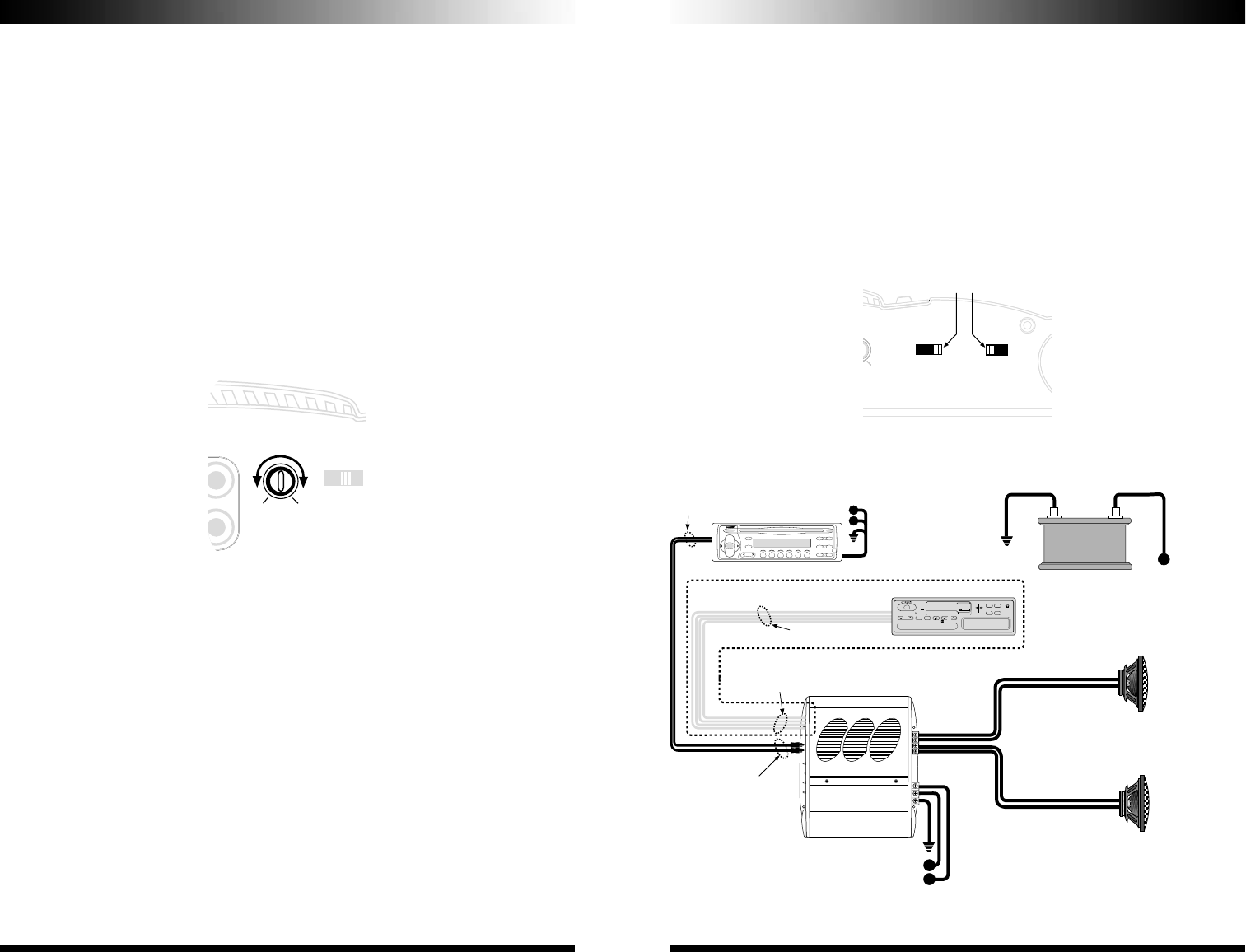
FINAL SYSTEM CHECK
INPUT SENSITIVITY ADJUSTMENT
The Input Sensitivity Control is located on the Front Panel. The objective of input sensitivity
adjustment is to match the output of the source unit with the input of the amplifier. The output
voltage of individual source units can vary. For example, some radios have an output of 200 mV,
others have 5 Volts or more. To cater to these variations, the 160SE amplifier has an adjustable
input sensitivity level that ranges from 100 mV to 5 volts.
Adjusting this control requires some experimenting. Basically you want all the gain at the begin-
ning of the system, NOT at the end (amplifier). Turn your headunit volume UP and keep your
amplifier gains at the minimum possible settings. This will give you the best sound and lowest
signal to noise ratio.
Besides better sonic reproduction, proper input sensitivity also helps to prolong the reliability
span of your amplifier by eliminating excessive internal temperature generated by incompatible
source unit output and amplifier input.
Note : Turning the input gain UP does NOT indicate MORE power. Just MORE noise. The input
gain control IS NOT a power control. REMEMBER that the input gain control has nothing to do
with the power output of the amplifier.
Figure 9: Input Sensitivity Control
1. Turn the Input Sensitivity Control all the way down (counter clockwise).
2. Set the volume control of the source unit to approximately 2/3 of its maximum output.
3. Turn the balance control of the source unit to its center position.
4. Leave the tone (bass/treble) controls at their usual position.
5. Play a CD or tape track with greater dynamic range
6. To locate the optimum input sensitivity setting, ask the person assisting you to turn the Input
Sensitivity Control clockwise until audio distortion starts to develop. Turn the sensitivity
control backwards slightly to minimize the distortion.
7. If you constantly switch between CD/tape and radio, you will need further adjustment since
radio output level differs from that of CD or tape. In this case, you need to locate a balanced
sensitivity setting which is best for both the output level of radio and that of CD or tape.
CROSSOVER SELECTION
The amplifier has built-in high-pass/low-pass filters that can be defeated by sliding the switch to
the OFF position.
1. When the high-pass is selected, the amplifier will be devoted to mid/tweeters.
2. When the low-pass is selected, the amplifier will be used to drive woofers/subwoofers.
3. When the filter is switched off, the amplifier is used as a full range amplifier.
CROSSOVER FREQUENCY SELECTION
Both the high-pass and the low-pass section offer 2 crossover frequencies - 80 and 120 Hz.
Choose the setting according to your speaker component specification or to your particular
preference.
Figure 10: Crossover Frequency Selection
Figure 11. Typical System connection
12
13
www.coustic.com
5 volts .1 volt
NPUTOUTPUT INPUT
30
180
SENS
MIN MAX
MODE
HPF OFF LPF
30
180
80 120
S
MAX
MODE
HPF OFF LPF
FREQ
80 120
S
MAX
MODE
HPF OFF LPF
FREQ
80Hz - Low-pass selected
231456
LOUD
CD-328
–
+
LOUD MUTE
ASM MONO
DISP WB
P.CL
SHUF RPT SCAN EAS P.ME P.PLA
TUNE
SEL
MODE
BAND
DISC
PWR
EJECT
REL
II
FRONT speaker
lead Inputs
LoZ
option 2
HS-652a
6 1/2 inch Co-Axial
160SE
POWER AMPLIFIER
(crossover set at 80Hz)
A
B
CD527 CD/RECEIVER
and CD CHANGER CONTROL
2
T.
RPT
3
Auto Aligned
Azimuth System
D.SCAN
1 4 5 6
TP
S
70µ
S
POWER
PRO
G
MODE
AS
M
DOLBY B
RX-779
SHUFF T.SCAN D.RPT P.PLAY
LOU
D
DIS
C
P. M E
M
TRACK
RESE
T
– +
A.S.
®
CD Changer Control
TUNE
SEEK
70µs TPS
AM FM 1 2
3
ST
LOUD
SHUFF D.SCAN DISC D.RPT
TRACK
ME
DIS
P
BAN
D
P. C
L
OPTION 1 -RCA Outputs
OPTION 2 -Speaker lead Outputs
(Note: You cannot use both RCA and
speaker lead inputs simultaneously!!)
A
B
Battery
B
Anybody’s leased car: high power In dash
FRONT
speaker lead
outputs
RCA
outputs
FRONT RCA
lead Inputs
HiZ
option 1
–
+
–
+













